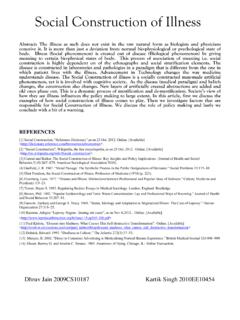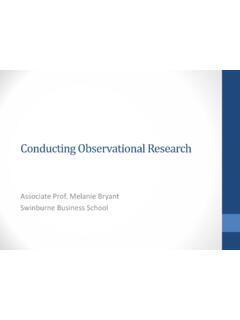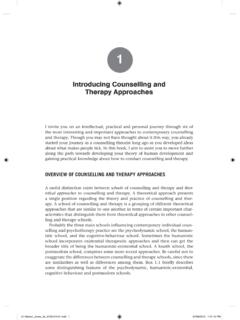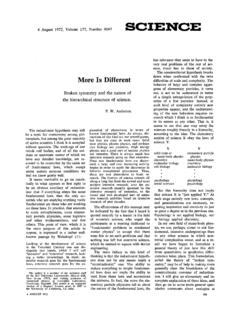Transcription of Ontological, Epistemological and Methodological ...
1 Ontological, Epistemological and Methodological Assumptions: Qualitative Versus Quantitative Abdelhamid Ahmed Assistant Lecturer at The Curriculum & Instruction Dept., Faculty of Education, Helwan University, Egypt. Currently, a PhD student at School of Education & Lifelong Learning, University of Exeter, UK 2008 1 Introduction The review to follow is a comparative analysis of two studies conducted in the field of TESOL in Education published in TESOL QUARTERLY. The aspects to be compared will be as follow. First, brief description of each study will be presented. Second, the ontological, Epistemological and Methodological assumptions underlying each study will be compared.
2 Third, the ethical issues that researchers of each study breached will be pinpointed. In addition, some aspects of the socio-political contexts of each study will be handled. Finally, a critique of each study will be presented. Brief Description of the First Study The first study in the comparison is entitled: Becoming Black Lambs Not Parrots : A Poststructuralist Orientation to Intelligibility and Identity. The aim of this study is to answer the following question: How do international speakers of English assert their identities as legitimate teachers of English given the privileged position of the native speakers? To answer this question, case studies of two Taiwanese students in their first year of study in a two- year Master of Arts in TESOL (MA TESOL) programme were presented. The data was collected using interviews and reaction papers written in a pronunciation pedagogy course in response to challenging readings.
3 At first, it was found out that the pre-service teachers had multiple and conflicting identities as legitimate speakers and teachers of English. The interviews and the written texts were analysed using the constant comparative method in which categories were coded and compared across similar incidents in the same category. Two main findings were highlighted: First, these teachers were able to appropriate and imagine new identities as legitimate speakers and teachers of English through the linguistic resources provided by the course readings. Second, these teachers also recognized that they had other means besides native-like pronunciation to establish their legitimacy as competent speakers and teachers of English. 1 Brief Description of the Second Study The second study is entitled: The Effects of Listening Support on The Listening Performance of EFL Learners.
4 It is designed to develop the listening performance of EFL learners. It is considered a support for 160 Business college Taiwanese students whose listening performance is low. The researchers of the present 1 Golombek, P. & Jordan, S. (2005). Becoming Black Lambs Not Parrots : A Poststructuralist Orientation to Intelligibility and Identity. TESOL QUARTERLY Vol. 39, No. 3. 2study investigated the effects of four different types of listening support: previewing the test questions, repetition of the input, providing background knowledge about the topic and vocabulary instructions. Samples used were of least and most anxious students. The researchers conducted their experiment on four groups of intact classes. The groups were exposed to the four different types of listening support mentioned earlier.
5 Results showed that the most effective type of treatment was providing background knowledge about the topic, followed by repetition of the input. As for previewing test questions, it had little significance. Vocabulary instruction was the least useful type of support. 2 The Ontological Assumptions Prior to clarifying the type of ontology used in these studies, it is important to define ontology. Ontology is defined by (Crotty: 2003:10) as the study of being . It is concerned with what kind of world we are investigating, with the nature of existence, with the structure of reality as such . Guba and Lincolin (1989:83) state that the ontological assumptions are those that respond to the question what is there that can be known? or what is the nature of reality? Having given these definitions of ontology, it is now worth identifying the ontology of the first study.
6 The first study uses an ontology which is essentially of a social world of meanings. In this world, researchers have to assume that the world they investigate is a world populated by human beings who have their own thoughts, interpretations and meanings. The researchers investigation of this world is clearly manifested in their use of the different research methods and techniques of the interpretive design such as interviews and reaction papers written in a pronunciation course in response to challenging readings in order to interpret the students feelings, and inner thoughts. Moreover, using the case study as a methodology of the present study focuses the students opinions, feelings, experiences and inner thoughts. As for the second study, it adopts a realistic ontology. One that follows the physical world in which the researchers assume the existence of a world of cause and effect.
7 It is not ontology of mechanical causes caught in the cause-effect relationships. In this study, the researchers assume that there are some realities the four different types of listening support mentioned earlier , which exist in the world and may affect the listening performance of the 160 business Taiwanese college students. So, I think that they follow a realistic ontology I also think that they view it as a causal reality. Pring (2004:62) referred to this notion saying One purpose of research is to explain what is the case or what has happened. A reason for seeking explanations 2 Chang, A. & Read, J. (2006). The Effects of Listening Support on the Listening Performance of EFL Learners. TESOL QUARTERLY Vol. 40, No. 2. 3might be to predict what will happen in the future or what would happen if there were to be certain interventions.
8 This is clearly shown in the aim of the study that is targeted at examining the effects of different listening support on developing the listening performance of the 160 Taiwanese business college students. This means that the researchers are looking for what will happen to the students if we use a certain type of listening support. They assume that any improvement in the students performance may be attributed to the listening support intervention. The Epistemological Assumptions Epistemology is a way of understanding and explaining how we know what we know , (Crotty,2003:3). Epistemology is also concerned with providing a philosophical grounding for deciding what kinds of knowledge are possible and how we can ensure that they are both adequate and legitimate. (Maynard, 1994:10) in Crotty, Ibid, 8). The Epistemological stance used in the first study is constructionism.
9 Constructionism is defined by Crotty (2003:42) as the view of that all knowledge and therefore all meaningful reality as such is contingent upon human practices, being constructed in and out of interaction between human beings and their world and developed and transmitted within an essentially social context. Thus, meaning is not discovered, but constructed. The reasons why constructionism is the Epistemological stance of the first study are as follow. First, the researchers are trying to find an answer to the question How do international speakers of English assert their identities as legitimate teachers of English given the privileged position of the native speakers? by presenting case studies of two Taiwanese students in their first year of study in a two-year Master of Arts in (MA TESOL) programme. Second, the construction of meaning is transmitted within an essentially social context this is shown in the interviews and reaction papers.
10 Finally, constructionists view that there is no true or valid interpretation. This is represented in the conclusion as researchers suggest new directions for pronunciation pedagogy in general and for teacher education in particular. These suggestions do not mean that they are true or valid. So, the present study is an invitation to reinterpretation. As for the second study, objectivism is the Epistemological stance. Objectivist epistemology holds according to (Crotty, Ibid) that meaning, and therefore meaningful reality, exists as such apart from the operation of the any consciousness. It means that the mind of the investigator is thought to be separate of the world of objects, of what is investigated. In the second study, the researchers separated themselves away 4from the objects they are studying. They are looking for the effect of listening support (as realities exist in the world) on the listening performance of EFL learners.















